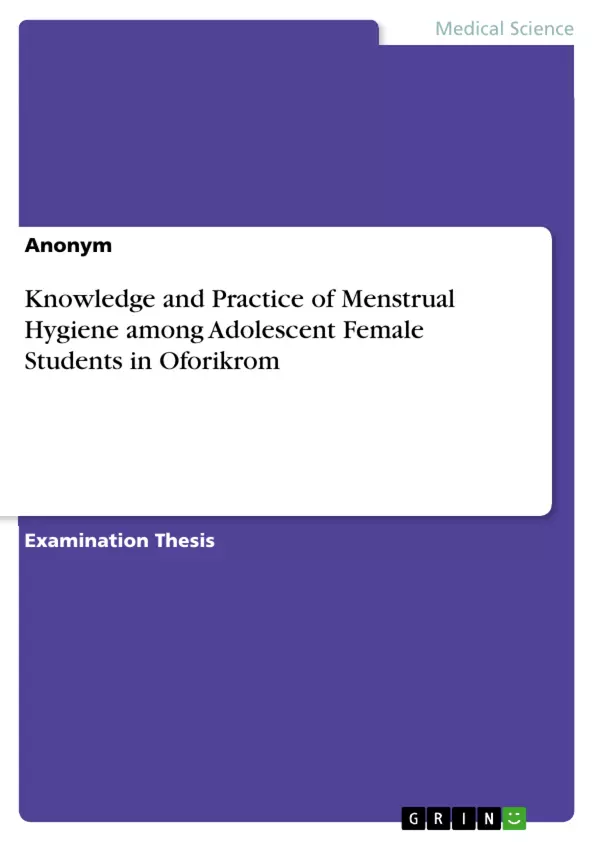The objective of this study is to assess the knowledge and practice of menstrual hygiene among high school girls at Oforikrom, Kumasi. The issue of menstrual hygiene is inadequately acknowledged and has not received proper attention. Use of sanitary pads and washing the genital area are essential practices to keep the menstrual hygiene. Unhygienic menstrual practices can affect the health of the girls and there is an increased vulnerability to reproductive tract infections and pelvic inflammatory diseases and other complications.
A school based cross-sectional study design was employed in the study. A multi stage sampling technique was used to select 200 female junior high school students. Data collection was carried out from the students in their schools and homes using a pre- tested structured questionnaire. The data were entered into a computer using Excel and then exported to SPSS for Windows version 22 for analysis. Bivariate and multivariate logistic regression analysis was done at 95 % confidence interval.
Table of Contents
- ABSTRACT
- DEDICATION
- ACKNOWLEDGEMENT
- CHAPTER ONE: INTRODUCTION
- 1.1 Background to the Study
- 1.2 Statement of the Problem
- 1.3 Objectives of the Study
- 1.4 Research Questions
- 1.5 Significance of the Study
- 1.6 Scope of the Study
- 1.7 Limitations of the Study
- 1.8 Definition of Terms
- CHAPTER TWO: LITERATURE REVIEW
- 2.1 Menstrual Hygiene
- 2.2 Importance of Menstrual Hygiene
- 2.3 Factors Influencing Menstrual Hygiene Practices
- 2.4 Practices Related to Menstrual Hygiene
- 2.5 Menstrual Hygiene Management: A Global Perspective
- 2.6 Studies on Menstrual Hygiene in Ghana
- CHAPTER THREE: MATERIALS AND METHODS
- 3.1 Study Design
- 3.2 Study Setting
- 3.3 Study Population
- 3.4 Sample Size and Sampling Technique
- 3.5 Data Collection Tools
- 3.6 Data Collection Procedure
- 3.7 Data Analysis
- CHAPTER FOUR: RESULTS
- 4.1 Socio-demographic Characteristics of Respondents
- 4.2 Knowledge of Menstrual Hygiene
- 4.3 Practice of Menstrual Hygiene
- 4.4 Factors Associated with Knowledge of Menstrual Hygiene
- 4.5 Factors Associated with Practice of Menstrual Hygiene
- CHAPTER FIVE: DISCUSSION
- 5.1 Knowledge of Menstrual Hygiene
- 5.2 Practice of Menstrual Hygiene
- 5.3 Factors Associated with Knowledge and Practice of Menstrual Hygiene
- 5.4 Implications of the Findings
- 5.5 Recommendations
- 5.6 Conclusion
- REFERENCES
Objectives and Key Themes
This thesis aims to assess the knowledge and practice of menstrual hygiene among adolescent female students in Oforikrom, Kumasi. The study employs a school-based cross-sectional design to gather data from 200 junior high school students using a structured questionnaire. The primary objective is to determine the prevalence of good knowledge and practice of menstrual hygiene among these students. Key themes explored in the thesis include:- The prevalence and factors influencing knowledge of menstrual hygiene among adolescent girls.
- The prevalence and factors influencing practice of menstrual hygiene among adolescent girls.
- The association between knowledge and practice of menstrual hygiene, and factors such as education level of mothers, access to media, and financial resources.
- The need for health education programs to promote awareness and good practice of menstrual hygiene among adolescent girls.
Chapter Summaries
- Chapter One: Introduction provides the background of the study, outlining the significance of menstrual hygiene and highlighting the gap in knowledge and practice among adolescent girls. The chapter defines the problem, objectives, and research questions, outlining the scope and limitations of the study.
- Chapter Two: Literature Review explores the existing literature on menstrual hygiene, discussing its importance, influencing factors, and common practices. It also examines global perspectives on menstrual hygiene management and reviews studies conducted in Ghana.
- Chapter Three: Materials and Methods details the study design, setting, population, sample size, data collection tools, procedure, and analysis methods employed in the research.
- Chapter Four: Results presents the findings of the study, including the socio-demographic characteristics of the respondents, the prevalence of knowledge and practice of menstrual hygiene, and the factors associated with both.
- Chapter Five: Discussion interprets and analyzes the results, highlighting the implications of the findings and offering recommendations for improving knowledge and practice of menstrual hygiene among adolescent girls. The chapter concludes by summarizing the key findings of the study.
Keywords
The key themes and focus topics of this research include menstrual hygiene, adolescent girls, knowledge, practice, factors influencing, health education, reproductive health, school-based study, Ghana, Oforikrom, Kumasi. The research explores the prevalence of good knowledge and practice of menstrual hygiene among adolescent girls in Oforikrom, Kumasi, investigating the factors influencing their understanding and behavior. It also emphasizes the importance of educational interventions to promote awareness and good practices related to menstrual hygiene.- Quote paper
- Anonym (Author), 2020, Knowledge and Practice of Menstrual Hygiene among Adolescent Female Students in Oforikrom, Munich, GRIN Verlag, https://www.grin.com/document/923660



